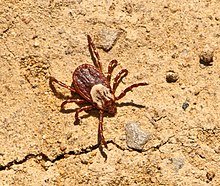| Dermacentor Temporal range:
| |
|---|---|

| |
| Dermacentor occidentalis | |
| Scientific classification | |
| Kingdom: | |
| Phylum: | |
| Class: | |
| Subclass: | |
| Superorder: | |
| Order: | |
| Family: | |
| Genus: | Dermacentor |
| Type species | |
| Dermacentor reticulatus (Fabricius, 1794)
| |
| Synonyms | |
| |
Dermacentor is a genus of ticks in the family Ixodidae, the hard ticks. The genus has a cosmopolitan distribution, with native species on all continents except Australia. Most are found in North America.[2]
Hosts of Dermacentor ticks include many large and small mammals, including horses, deer, cattle, lagomorphs, peccaries, porcupines, tapirs, desert bighorn sheep, and humans.[2] The American dog tick (D. variabilis) is a member of the genus.[3]
Dermacentor species are vectors of many pathogens, including Rickettsia rickettsii, which causes the disease Rocky Mountain spotted fever, Coxiella burnetii, which causes Q fever, Anaplasma marginale, which causes anaplasmosis in cattle, Francisella tularensis, which causes tularemia, Babesia caballi, which causes equine piroplasmosis, and the Flavivirus that causes Powassan encephalitis.[2] Dermacentor ticks inject a neurotoxin that causes tick paralysis.[2]
- ^ Don R. Arthur (1960). "The genus Dermacentor: 1. General". The genera Dermacentor, Anocentor, Cosmiomma, Boophilus, Margaropus. Ticks. Vol. 5. Cambridge University Press. pp. 6–37.
- ^ a b c d C. E. Yunker; J. E. Keirans; C. M. Clifford; E. R. Easton (1986). "Dermacentor ticks (Acari: Ixodoidea: Ixodidae) of the New World: a scanning electron microscope atlas" (PDF). Proceedings of the Entomological Society of Washington. 88 (4): 609–627. Archived from the original (PDF) on 2013-10-29. Retrieved 2013-09-04.
- ^ W. Chen; P. E. Kaufman (2008). "American Dog Tick, Dermacentor variabilis (Say) (Arachnida: Ixodida: Ixodidae)". Entomology and Nematology. Florida Cooperative Extension Service. University of Florida Institute of Food and Agricultural Sciences. EENY-443. Retrieved December 4, 2013.